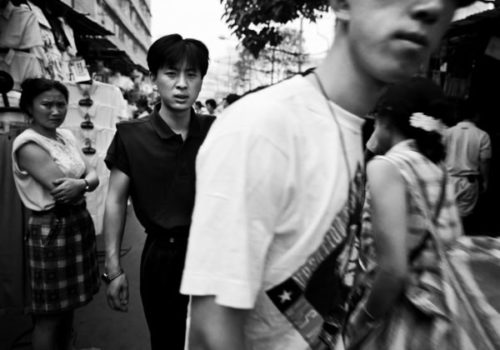Born in 1958 in Chengdu, the capital of Sichuan Province in Southwestern China, Mingyi Luo has been practising photography, interior architecture and painting for almost thirty years. His main field of investigation is the city, particularly in its collective and social aspects – homeless people, migrant workers, the relocation of funerary rites and the local stock exchange. His series People on the Qingnian Road – Lost Desire was awarded the Special Jury Award at the Lianzhu International Festival in 2010.
1991–1999 was a unique period in the evolution of Chinese society. Mingyi Luo was one of the rare photographers – perhaps the only one – to commit this period to memory and play a part in writing history as it unfolded, focusing on two Chengdu streets, Qingnian Road and Chunxi. As a former shopkeeper he was familiar with the atmosphere of shops overflowing onto the pavement, and their customers. For ten years he photographed, in black and white and in a square format, the sudden appearance of Western clothing in Sichuan Province, a style instantly adopted by the population as an escape from the uniforms formerly imposed by the Maoist regime. These hats and pleated trousers may be laughable, but they denote deep changes – an affirmation of identity, individuality and freedom, as well as a symbol of adaptation to Western fashions. A form of quiet protest and evidence of an emerging middle class.
Beyond the sociological aspect, the aesthetic, photographic approach to this phenomenon is striking in its own right. These stolen moments, captured deliberately in black and white, avoiding all anecdotal artefacts, the tight framing and above all, the recourse to wide angles – uncommon in square format images – plunge the spectator into the crowd. Luo claims a closeness between his amazingly effective documentary series, with its symbolism and sharply honed vision, and the work of William Klein, discovered in a book late in his career. Japanese photographer Nobuyoshi Araki drew attention to the relevance of this series before
Christian Caujolle, curator
Text from the catalogue-book “Photoquai”, co-edited by Musée du Quai Branly- Actes-Sud
















